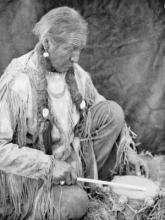Article
A communal and spiritual leader in the Native American church. Formed in 1918 as a Pan-Indian movement and in response to government abuses and relocations, the Native American Church centers on the sacramental use of peyote, a small, spineless cactus that grows primarily in Texas and Mexico. Although using peyote for religious purposes precedes the church in various tribes, the Native American Church is the first, large organized spiritual establishment across tribes. The church still exists today, despite U.S. legal objections to the use of peyote, which is classified as a controlled substance.
Services usually take place on weekends, but there is no set schedule, and many gatherings occur in the context of healing ceremonies, blessings, or prayers for specific individual or community needs. Peyote is a psychoactive substance, and participating members often have visions, but it is the community experience of these effects that gives the ceremony spiritual power. The peyote chief is the one who conducts services and ceremonies according to the specific traditions of the tribe. This is a sacred learned skill that chosen chiefs transmit through the generations.
"Peyote drummer, c 1927" by Edward S. Curtis is licensed under Public Domain.
Manuscripts
A06 People of Darkness (03-06) p. 56
A06 People of Darkness (03-06) p. 57
A06 People of Darkness (03-06) p. 58
A06 People of Darkness (03-06) p. 59
A06 People of Darkness (03-06) p. 60
A06 People of Darkness (03-06) p. 141
A06 People of Darkness (03-06) p. 185
A06 People of Darkness (03-06) p. 201
A06 People of Darkness (03-06) p. 204
A06 People of Darkness (03-06) p. 225
References
Aberele, David F.
1966 The Peyote Religion Among the Navaho. Viking Fund Publications in Anthropology,
No. 42. New York: Wenner-Gren Foundation for Anthropological Research.
Hirschfelder, Arlene and Paulette Molin
2000 Encyclopedia of Native American Religions. New York: Checkmark Books.

